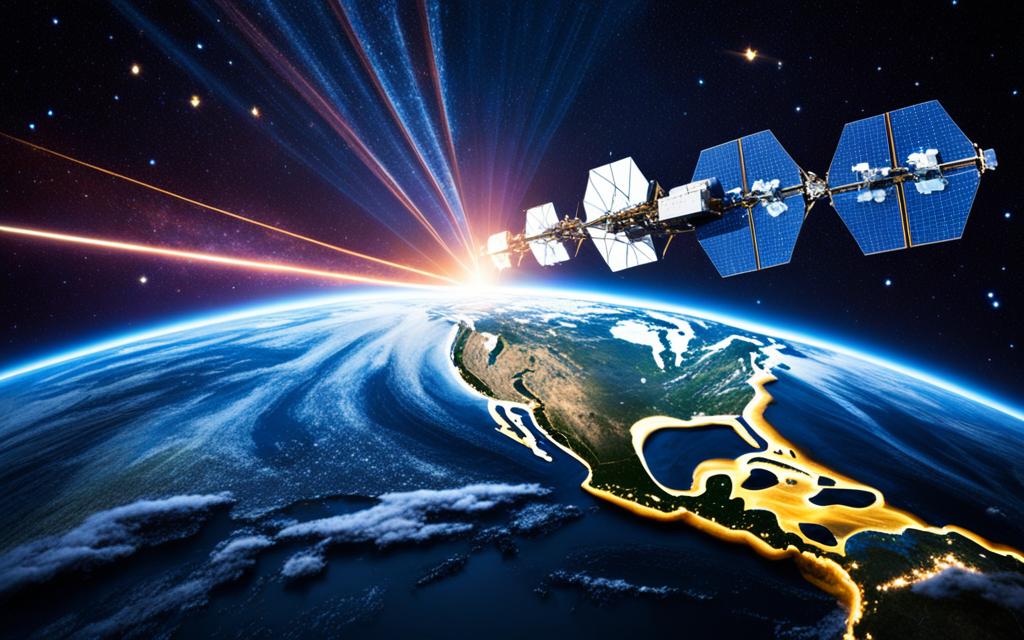Starlink is a revolutionary satellite internet service developed by SpaceX, the aerospace company founded by Elon Musk. Unlike traditional satellite internet, which relies on large, high-altitude satellites, Starlink utilizes a network of low-Earth orbit (LEO) satellites to provide high-speed, low-latency internet access to users around the world.
By harnessing the power of this innovative Starlink internet technology, you can experience the benefits of lightning-fast and dependable internet connectivity, no matter where you are. In this article, we’ll dive deep into the inner workings of Starlink, exploring how this cutting-edge system delivers on its promise of transforming the way we access the internet.
Introduction to Starlink
Starlink is a satellite internet service provided by SpaceX, the innovative aerospace company founded by Elon Musk. Announced in 2015, the Starlink project aims to create a global high-speed internet network by deploying a vast constellation of small satellites in low-Earth orbit (LEO). This revolutionary technology promises to bring reliable, high-speed internet access to even the most remote regions of the world, where traditional terrestrial internet infrastructure has been challenging to establish.
Starlink’s satellite internet service operates by utilizing a network of thousands of miniaturized satellites orbiting the Earth at an altitude of approximately 550 kilometers. This constellation of LEO satellites works in tandem to provide seamless, low-latency internet connectivity to users on the ground, offering download and upload speeds that can rival or even surpass traditional broadband options.
Unlike traditional satellite internet services that rely on large, high-altitude satellites, Starlink’s approach leverages the unique advantages of LEO satellites, including lower latency and improved signal strength. This enables Starlink to deliver a superior internet experience, with reduced lag and improved reliability, making it an attractive option for a wide range of users, from rural households to businesses in remote areas.
As Starlink continues to expand its satellite network and ground infrastructure, the company aims to provide global internet coverage, connecting people and communities worldwide that have historically lacked access to reliable, high-speed internet. This ambitious project has the potential to bridge the digital divide and revolutionize the way we access information and communicate in the 21st century.
| What is Starlink? | Starlink Satellite Internet | Starlink Company |
|---|---|---|
| Starlink is a satellite internet service developed by SpaceX, the aerospace company founded by Elon Musk. It aims to create a global high-speed internet network by deploying a vast constellation of small satellites in low-Earth orbit (LEO). | Starlink’s satellite internet service operates by utilizing a network of thousands of miniaturized satellites orbiting the Earth at an altitude of approximately 550 kilometers. This constellation of LEO satellites provides seamless, low-latency internet connectivity to users on the ground. | SpaceX, the innovative aerospace company founded by Elon Musk, is the company behind the Starlink project. Announced in 2015, Starlink’s goal is to bring reliable, high-speed internet access to even the most remote regions of the world. |
How Starlink Provides Internet
Starlink’s internet service is delivered through a complex network of satellites, user terminals, and ground stations. Here’s a closer look at how it all works:
At the heart of the Starlink system are the satellites orbiting the Earth in low-Earth orbit (LEO). These satellites are responsible for transmitting and receiving data, relaying it between user terminals and the ground stations.
Each Starlink user is equipped with a small, user-friendly terminal, often referred to as a “Starlink dish.” This terminal communicates directly with the nearest Starlink satellite, establishing a high-speed, low-latency connection. The terminal then connects to the user’s local network, providing internet access to their devices.
The data transmitted from the user terminal is then routed through the network of Starlink satellites, which are designed to communicate with each other and pass the data along to the nearest ground station. These ground stations, strategically placed around the world, connect the Starlink network to the broader internet infrastructure, allowing for seamless data transmission and internet access for Starlink users.
By leveraging this complex, interconnected system of satellites, user terminals, and ground stations, Starlink is able to deliver high-speed, low-latency internet to users in even the most remote and underserved areas, revolutionizing the way people access the internet worldwide.
How Does Starlink Work?
Starlink’s internet service operates through a complex network of satellites, user terminals, and ground stations. The key components that enable this high-speed, low-latency connectivity include:
- Satellite-to-Satellite Communication: Starlink’s constellation of satellites is designed to communicate with each other, forming a mesh network that can transmit data across long distances without the need for ground infrastructure.
- Satellite-to-Ground Communication: Each Starlink satellite is capable of communicating directly with user terminals on the ground, as well as with a network of ground stations that connect the satellite network to the broader internet infrastructure.
- Data Transmission: The data transmitted from user terminals is routed through the satellite network and ground stations, eventually reaching its destination on the internet. This process happens in near-real-time, enabling the low-latency performance that sets Starlink apart from traditional satellite internet services.
To ensure reliable and seamless internet connectivity, Starlink employs advanced technologies like beam-forming antennas, phased array systems, and sophisticated software algorithms to optimize the flow of data across its network. This integrated approach allows Starlink to deliver high-speed internet access to users in even the most remote and underserved areas of the world.
The combination of Starlink’s low-Earth orbit satellite network, user terminals, and ground infrastructure creates a powerful and versatile internet solution that can adapt to the unique needs and challenges of different regions and environments. As Starlink continues to expand and refine its technology, it is poised to revolutionize the way the world accesses the internet, bringing high-speed connectivity to even the most remote corners of the globe.
Starlink’s Network Architecture
Starlink’s innovative network architecture is the backbone of its high-speed, low-latency internet service. At the heart of this system are the thousands of satellites that make up the Starlink constellation, strategically positioned in low-Earth orbit (LEO) to provide coverage across the globe.
Each Starlink satellite is equipped with powerful phased-array antennas, allowing them to communicate with one another and with ground stations located around the world. This satellite-to-satellite and satellite-to-ground communication forms the backbone of the Starlink network, enabling data to be seamlessly transmitted across the entire system.
To connect users, Starlink relies on its user terminals, which are small, flat antennas that can be easily installed at homes and businesses. These terminals communicate directly with the nearest Starlink satellites, establishing a high-speed, low-latency link that provides internet access to the end-user.
Underpinning this entire system is Starlink’s advanced software and control system, which manages the complex choreography of the satellite network, ensuring optimal performance and seamless connectivity for all users.
| Key Components | Description |
|---|---|
| Starlink Satellites | Thousands of low-Earth orbit (LEO) satellites that form the backbone of the Starlink network, equipped with powerful antennas for communication. |
| Satellite-to-Satellite Communication | Enables data to be seamlessly transmitted across the entire Starlink network, with satellites communicating with one another. |
| Satellite-to-Ground Communication | Allows Starlink satellites to communicate with ground stations located around the world, providing the necessary infrastructure for internet connectivity. |
| User Terminals | Small, flat antennas installed at homes and businesses that connect directly to the nearest Starlink satellites, delivering high-speed, low-latency internet access. |
| Advanced Software and Control System | Manages the complex coordination of the Starlink network, ensuring optimal performance and seamless connectivity for all users. |
Advantages of Starlink
Starlink’s innovative satellite internet technology offers several key advantages over traditional internet solutions:
- High-Speed Connectivity: Starlink’s low-Earth orbit satellites enable download and upload speeds that rival or even exceed those of traditional fiber-optic and cable broadband networks, providing users with a lightning-fast internet experience.
- Low Latency: With satellites orbiting much closer to Earth than traditional satellite internet systems, Starlink delivers significantly lower latency, allowing for smoother video conferencing, online gaming, and real-time data transmission.
- Global Accessibility: Starlink’s goal is to provide internet access to even the most remote and underserved areas of the world, bridging the digital divide and connecting communities that have long been left behind by traditional internet infrastructure.
- Reliability and Redundancy: Starlink’s network of satellites provides a high degree of redundancy, ensuring that users maintain a stable internet connection even in the event of disruptions to ground-based infrastructure.
| Feature | Starlink | Traditional Satellite Internet |
|---|---|---|
| Download Speeds | 100-200 Mbps | 25-50 Mbps |
| Latency | 20-40 ms | 500-800 ms |
| Availability | Global, including remote areas | Limited to certain regions |
| Reliability | High redundancy, stable connection | More prone to disruptions |
Challenges and Limitations
Despite the numerous advantages of Starlink, the service also faces several challenges and limitations that must be addressed. One of the primary concerns is the potential impact of Starlink’s satellite constellation on astronomy and space exploration. The growing number of satellites in low-Earth orbit has raised concerns among astronomers about interference with ground-based observations and the potential for collisions with other spacecraft.
Another limitation of Starlink is the cost of the user equipment, which includes a satellite dish and other hardware. While Starlink aims to make the service more affordable over time, the initial investment required from customers can be a barrier, especially in developing countries where access to reliable internet is most needed.
| Challenge | Description |
|---|---|
| Environmental Impact | The launch and operation of Starlink satellites have raised concerns about their potential impact on the environment, including greenhouse gas emissions and the accumulation of space debris. |
| Regulatory Hurdles | Starlink must navigate a complex web of international regulations and obtain approvals from various government agencies in order to operate in different regions, which can slow down the deployment process. |
| User Adoption | While Starlink offers promising performance, the service must still convince potential customers to switch from their existing internet providers, which can be a significant challenge, especially in areas with well-established terrestrial broadband infrastructure. |
These challenges and limitations highlight the ongoing work required to make Starlink a truly global and widely accessible internet solution. As the technology continues to evolve and the company addresses these issues, Starlink’s impact on the world’s connectivity landscape is likely to become even more transformative.
Conclusion
In conclusion, Starlink’s innovative satellite internet technology represents a significant leap forward in the quest to bring high-speed, low-latency internet access to people around the world. By leveraging a constellation of low-Earth orbit satellites, Starlink is able to deliver internet speeds and performance that rival or even exceed traditional terrestrial broadband options.
The pros of Starlink include its ability to provide internet access to remote and underserved areas, low latency, and the potential for global coverage. However, the service also faces some limitations, such as the initial high cost of equipment, the need for a clear line of sight to the satellites, and potential interference from other satellite constellations.
Overall, the conclusion on how Starlink works is that it represents a game-changing innovation in the world of internet connectivity, with the potential to bridge the digital divide and bring high-speed internet to people in even the most remote corners of the globe. As the pros and cons of Starlink continue to be explored, it will be fascinating to see how this technology evolves and shapes the future of global connectivity.










